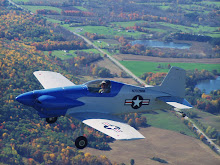My airplane building career started back in the early 1960's while I was in the Navy and stationed in the
San Diego, CA area. I sent away for the plans to build a Midget Mustang The plane was designed by David Long following WWII. At that time the plans were maintained and sold by Bob
Bushby. I started making small parts and completed all the wing ribs and welded fittings before I left the Navy. At that time there were no kit planes available, so everything was built from plans.
After I left the Navy, life got busy. I started a new career working as an engineer with a pretty wife, two great children and all the associated responsibilities. The airplane parts ended up in a corner of the basement. Except of one small venture, that was the end of my aircraft building. The venture was that I learned about Jim Bede's
BD-5. Jim was selling a completed airplane and I thought it would be a great plane to own and fly so I put a deposit down and hoped for the best. My hopes were in vain and Jim was never able to deliver on his promise, although there are several jet powered versions of the
BD-5 flying today.
Aviation was deep in my blood. I rented planes and bummed flights with friends. I flew a hang glider and several of the earliest ultralights, but when my daughter said she wanted to learn to fly ultralights, I thought it was time to go a different route. I bought an old Cessna 150 in 1982 and flew it for more than 2 years thinking it would be a great plane for her to learn to fly. In the mean time, she discovered boys and lost her interest in flying. I wanted to sell the 150 and buy a Pitts Special, but my family thought a Cessna 182 would be a better choice, so I purchased a half share in a
Skylane. That was one of the best moves I ever made. We still own and fly that fine plane and after good experiences with three partners, we now own it solo.
Now fast forward to the fall of 2002. My son was interested in finding a plane to build and eventually settled on the Midget Mustang. He suggested I finish mine and
that's how my plane building project was restarted. Thanks Brad... :-)
Construction started in the summer of 2003. The plane was built from a kit supplied by Mustang
Aero, which is operated by Chris
Tieman. They do a great job and are as helpful as can be expected. The building process was challenging, fun and satisfying. The plans covered the metal part of the plane and some of the systems, but I set out to build a high-tech aircraft so I was sort of on my own for all that stuff. The construction phase took about 4 years of calendar time and about 2200 hours of build time. The plane was moved from our house to the airport on July 23, 2007 (my wedding anniversary).
The plane I had built was equipped with a
tailwheel. All the other planes I had flown had nose wheels. Planes with nose wheels are much easier to takeoff and land than planes with
tailwheels. I prepared as best as I could to fly a tail
dragger. I got
certified in the famous old yellow Piper Cub. That was important, but the Cub was too easy to fly to enable me to fly the Midget. I got training in a
Citabria, but it too was too easy. I flew a Pitts Special, but it was way to hard to learn
enough with the money I had available for training. Lastly, I flew a Piper Pacer for an hour or so. All in all, I had a good idea of what had to be done, so I started running the Midget up and down the runway with the tail in the air. Eventually, after 100+ runs, I got the "hang of it". After that, it was time to find a day with good weather and light winds.
The first flight was October 4, 2007 (10/4 is the way I remember that date). It was
executing flying an airplane that I built with my own two hands. I was sure it was going to fly, but at the same time, I wondered if I had done everything correctly. And then there was the nagging problem of would I be able to land the plane. I had done lots of runs up and down the runway, but I had never really landed it. As it turns out, everything went well and the plane flew fine. It was much more sensitive than my Cessna 182 (which most people say
flys like a truck), but it was fun. A friend on the ground kept me focused on things like oil pressure and temperature and other stuff like that. I entered the landing pattern with the idea that I would make a couple of practice approaches, then try a landing. As I entered the landing flare everything looked so good I just landed and rolled out. I smiled for two days.
So far I have 14 hours of flight time logged and things are going as expected. I am still debugging problems, but everything is moving forward nicely. I'll tell you more about the building process and the flight testing in future posts.

